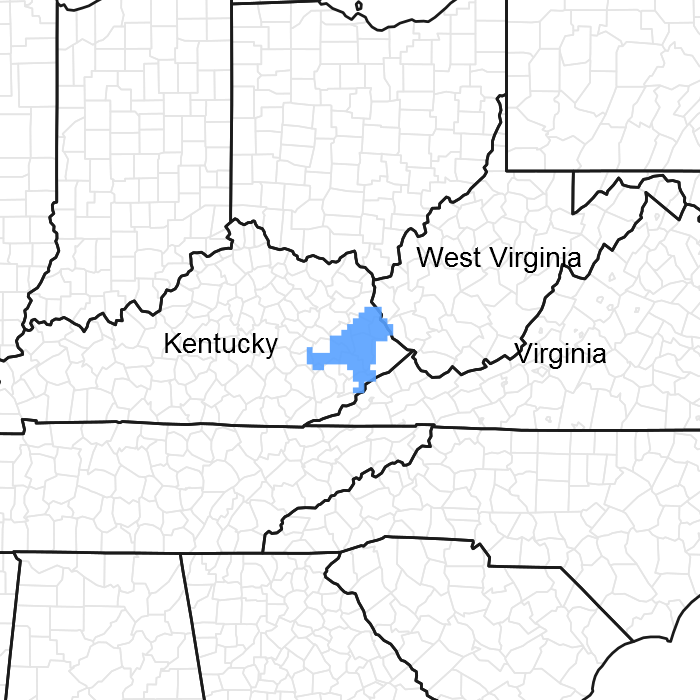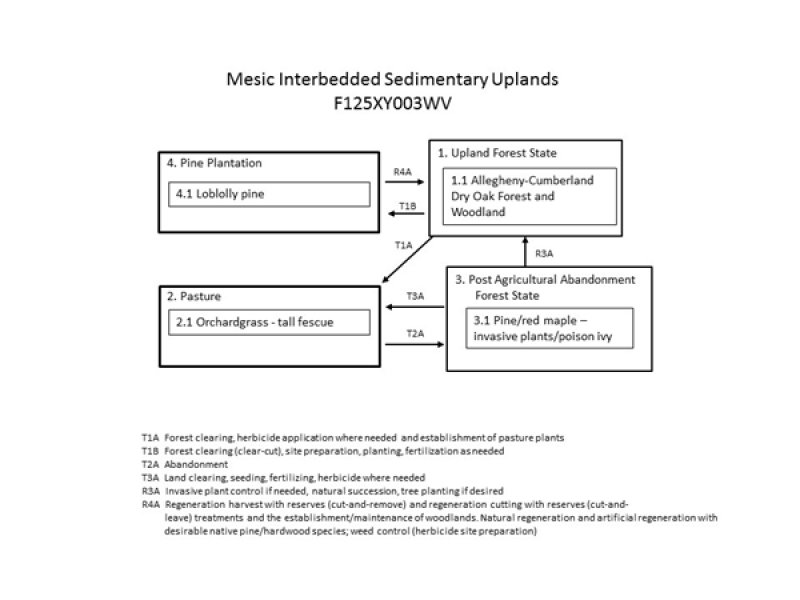
Natural Resources
Conservation Service
Ecological site F125XY003WV
Interbedded Sedimentary Uplands
Last updated: 9/27/2024
Accessed: 12/05/2025
General information
Provisional. A provisional ecological site description has undergone quality control and quality assurance review. It contains a working state and transition model and enough information to identify the ecological site.

Figure 1. Mapped extent
Areas shown in blue indicate the maximum mapped extent of this ecological site. Other ecological sites likely occur within the highlighted areas. It is also possible for this ecological site to occur outside of highlighted areas if detailed soil survey has not been completed or recently updated.
MLRA notes
Major Land Resource Area (MLRA): 125X–Cumberland Plateau and Mountains
This area is in Kentucky (43 percent), Tennessee (25 percent), West Virginia (20 percent), Virginia (9 percent), and Alabama (3 percent). It makes up about 20,330 square miles (52,685 square kilometers). The towns of Logan, Madison, Welch, and Williamson, West Virginia, and Norton and Wise, Virginia, are in the northeastern part of this area. The towns of Middlesboro, Williamsburg, Corbin, London, Hazard, and Pikeville, Kentucky, and La Follette and Crossville, Tennessee, are in the area. Chattanooga, Tennessee, and Huntsville, Alabama, are just outside the southeast and southwest corners, respectively.
Interstates 24, 64/77, 75, and 40/75 cross this area. The Cumberland Gap National Historic Park is in the part of this area along the Virginia and Kentucky border. The Daniel Boone and Jefferson National Forests occur in this area. Numerous State forests and parks are throughout the area (USDA-NRCS, 2006).
Classification relationships
This MLRA falls into the following Forest Service Sections: Northern Cumberland Mountains, Northern Cumberland Plateau. It falls into the following EPA Level III Ecoregions: Central Appalachians, Southwestern Appalachians, Central Appalachians (USDA-NRCS, 2006).
Ecological site concept
These are mixed upland oak sites where pines, hickories and eastern hemlock are also important. Dogwood, blackgum and red maple are commonly noted in the tree regeneration. Amphicarpaea bracteata, asters, panicums and violets are most commonly noted understory species.
There may be potential habitat in this PES for the golden-winged warbler, listed as a high conservation concern and prioritized by NRCS, among other agencies and organizations.
Associated sites
| F125XY001WV |
Sandstone Residuum |
|---|---|
| F125XY002WV |
Interbedded Sedimentary Colluvium |
| F125XY004WV |
Floodplain Alluvium |
| F125XY005WV |
Low Stream Terrace Alluvium |
Similar sites
| F125XY001WV |
Sandstone Residuum |
|---|
Table 1. Dominant plant species
| Tree |
(1) Quercus alba |
|---|---|
| Shrub |
Not specified |
| Herbaceous |
Not specified |
Click on box and path labels to scroll to the respective text.
